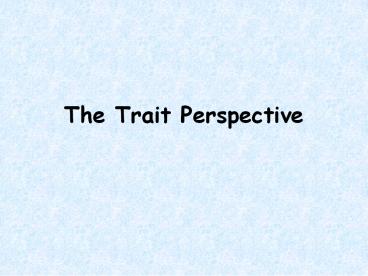The Trait Perspective - PowerPoint PPT Presentation
1 / 25
Title:
The Trait Perspective
Description:
... traits Central Traits Basic building blocks of personality that influence behavior ... but the resulting behavior in various situations is ... – PowerPoint PPT presentation
Number of Views:253
Avg rating:3.0/5.0
Title: The Trait Perspective
1
The Trait Perspective
2
In your notes
- In separate columns, list the traits you believe
to be positive and negative. - Critical thinking Activitiy pg. 494
3
Ancient Greek take on personality
- Hippocrates
- Four body fluids called humor (traits) can
determine personality - Yellow bile ? choleric, quick tempered
(irritable) - Blood ? warm, cheerful
- Phlegm ? sluggish, cool (unemotional)
- Black bile ? melancholy, thoughtful (depressed)
4
The Trait Perspective
- An individuals unique constellation of durable
dispositions and consistent ways of behaving
(traits) constitutes his or her personality.
Examples of Traits
Honest Dependable Moody Impulsive
Allport Odbert (1936), identified 18,000 words
representing traits.
5
Allports Hierarchy of Traits
- Cardinal Traits
- Pervasive characteristics that influence behavior
- MLK social justice
- Relatively few possess such dominate traits
- Central Traits
- Basic building blocks of personality that
influence behavior - Competitiveness, generosity, independence,
arrogance, fearfulness - Secondary Traits
- Superficial
- Preferences in clothes, music
- Influence behavior in relatively few situations
- More easily changed over time
6
Personality Type
- Personality types, assessed by measures like the
Myers-Briggs Type Indicator, consist of a number
of traits. For example, a feeling type
personality is sympathetic, appreciative, and
tactful. Thinking types prefer an objective
standard of truth and are good at analyzing
Feeling Type Personality
7
Exploring Traits
- Factor analysis is a statistical approach used to
describe and relate personality traits. - Cattell used this approach to develop a 16
Personality Factor (16PF) inventory.
Raymond Cattell (1905-1998)
8
Factor Analysis
Cattell found that large groups of traits could
be reduced down to 16 core personality traits
based on statistical correlations.
Impulsive
Cattell Inventory
9
Personality Dimensions
- Hans and Sybil Eysenck suggested that personality
could be reduced down to two polar dimensions,
extraversion-introversion and emotional
stability-instability.
10
Assessing Traits
- Personality inventories are questionnaires (often
with true-false or agree-disagree items) designed
to gauge a wide range of feelings and behaviors
assessing several traits at once.
11
MMPI
- The Minnesota Multiphasic Personality Inventory
(MMPI) is the most widely researched and
clinically used of all personality tests. It was
originally developed to identify emotional
disorders.
The MMPI was developed by empirically testing a
pool of items and then selecting those that
discriminated between diagnostic groups.
12
Characteristics of MMPI
- Developed in 1930s to distinguish between
normal and disturbed - Depression
- Hypochondria
- Schizophrenia
- MMPI-2 developed in 1989
- 557 Items presented in True/False format
- Divided into 10 clinical scales and 8 validity
scales with cutoff points for normal range of
score within each section - Social shyness
- Depression
- Suspiciousness
- Anxiety
- Scales used to determine how well the questions
were understood, how much the person lied
See p. 351 HS book
13
Sample MMPI-2 Questions
- My father was a good man.
- I am seldom troubled by headaches.
- My hands and feet are usually warm enough.
- I have never done anything dangerous or the
thrill of it. - I work under a great deal of tension.
14
Problems with MMPI
- The meaning attached to the items may be
misinterpreted - Examples
- Question People talk about me T F
- Answer might show paranoia or pride
- Question Agent of God T F
- Answer might show delusional or faithful
- Good place to start but not good by itself
15
MMPI Test Profile
16
The Big Five Factors
- Todays trait researchers believe that Eysencks
personality dimensions are too narrow and
Cattells 16PF too large. So, a middle range
(five factors) of traits does a better job of
assessment.
Conscientiousness
Agreeableness
Neuroticism
Openness
Extraversion
17
Endpoints
18
Questions about the Big Five
Quite stable in adulthood. However, they change
over development.
1. How stable are these traits?
2. How heritable are they?
Fifty percent or so for each trait.
These traits are common across cultures.
3. How about other cultures?
Yes. Conscientious people are morning type and
extraverted are evening type.
4. Can they predict other personal attributes?
19
Evaluating the Trait Perspective
- The Person-Situation Controversy
- Walter Mischel (1968, 1984, 2004) points out that
traits may be enduring, but the resulting
behavior in various situations is different.
Therefore, traits are not good predictors of
behavior.
20
The Person-Situation Controversy
- Trait theorists argue that behaviors from a
situation may be different, but average behavior
remains the same. Therefore, traits matter.
21
The Person-Situation Controversy
- Traits are socially significant and influence our
health, thinking, and performance
(Gosling et al., 2000).
John Langford Photography
Samuel Gosling
22
Consistency of Expressive Style
- Expressive styles in speaking and gestures
demonstrate trait consistency.
Observers are able to judge peoples behavior and
feelings in as little as 30 seconds and in one
particular case as little as 2 seconds.
23
Now for a bit of silliness
- William Sheldons Theory of Body Types
24
Sheldons Topology
- Physique Temperament
- Endomorphic Viscerotonic soft rel
axed round sociable overweight
tolerant - Mesomorphic
Somatotonic strong energetic muscul
ar assertive broad shouldered courageous - Ectomorphic Cerebrotonic long
timid, artistic thin
introvertive fragile intellectual
25
(No Transcript)































